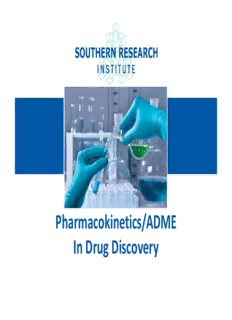
PK/ADME in Drug Discovery PDF
Preview PK/ADME in Drug Discovery
PPhhaarrmmaaccookkiinneettiiccss//AADDMMEE In Drug Discovery AAnn EExxaammppllee Identified a new compound for memory loss AAnniimmaall ssttuuddiieess PK/ADME in Drug Discovery OOverviiew • PPhhaarrmmaaccookkiinneettiiccss, aabbssoorrppttiioonn, ddiissttrriibbuuttiioonn, metabolism, elimination –– PPhhaarrmmaaccooddyynnaammiiccss • Why these are important in early research, ttaarrggeett vvaalliiddaattiioonn aanndd ddiissccoovveerryy pprrooggrraammss • When should they be determined – Early in the process • Examples Drug Development • Nine of every ten new drugs fail in clinical testing. –– AA ddrruugg iinn pphhaassee IIIIII tteessttiinngg hhaass 3322%% cchhaannccee ooff ffaaiilluurree. – Even in Phase I, 37% fail. – Most drugs fail in phase II. • Why – Laboratory rat and mice strains are too genetically homogeneous – The animal model is wrong, or the theory behind the disease is wrong – The ppharmacologgyy is done incorrectlyy – Other reasons?? – Rats and humans have different metabolic pathways –– TThheerree aarree uunnffoorreesseeeenn ssiiddee eeffffeeccttss AAttttrriittiioonn RRaattee CCoommppoouunndd FFaaiilluurreess Absorption, Distribution, Metabolism and EExcretiion • Absorption ‐ route of drug delivery – Whhere abbsorbbedd • Distribution ‐ where does the drug go, where does it need to go and what are the implications • MMeettaabboolliissmm ‐ tthhiiss wwiillll ooccccuurr aanndd ccoouulldd iimmppaacctt sseevveerraall vvaarriiaabblleess – Could be used to your advantage ‐ Prodrugs • Excretion – how is the drug eliminated • Pharmacokinetics is concerned with the variation in drug concentration with time as a result of absorption, metabolism, distribution and excretion – DDrruugg ddoossee,, rroouuttee ooff aaddmmiinniissttrraattiioonn,, rraattee aanndd eexxtteenntt ooff aabbssoorrppttiioonn,, ddiissttrriibbuuttiioonn rate (particularly to site of action) and rate of elimination – Pharmacokinetics may be simply defined as what the body does to the drug – Pharmacodynamics defined as what the drug does to the body DDrruugg DDeelliivveerryy ‐ EEnntteerraall RRoouutteess • Oral‐ by far the most common route. The passage of drug from the gut into the blood is influenced by biologic and physicochemical properties. • Sublingual (buccal) ‐ Certain drugs are best given beneath the tongue or retained in the cheek pouch and are absorbed from these regions into the local circulation. • Rectal ‐The administration of suppositories is usually rreesseerrvveedd ffoorr ssiittuuaattiioonnss iinn wwhhiicchh oorraall aaddmmiinniissttrraattiioonn iiss difficult. This route is more frequently used in small children. PPaarreennttaall RRoouutteess • Intravenous injjection – Used when a rapid clinical response is necessary, e.g., an acute asthmatic episode. – Achieve relatively precise drug concentrations in the plasma, since bioavailabilityy is not a concern. • Intra‐arterial injection – Used in certain sppecial situations,, notablyy with anticancer druggs,, in an effort to deliver a high concentration of drug to a particular tissue. Typically, the injected artery leads directly to the target organ. •• IInnttrraatthheeccaall iinnjjeeccttiioonn – The blood‐brain barrier limits the entry of many drugs into cerebrospinal fluid. life‐threatening, antibiotics, antifungals and anticancer drugs are given via lumbar puncture and injection into the subarachnoid space . PPaarreennttaall ((CCoonntt)) • Intramuscular injection – Drugs may be injected into the arm, thigh or buttocks. • Subcutaneous injection – Some drugs, notably insulin, are routinely administered SC. Drug absorption is generally slower SC than IM, due to poorer vascularity. •• IInnhhaallaattiioonn – Volatile anesthetics, as well as many drugs which affect pulmonary function, are administered as aerosols. Drugs administered via this route are not subject to first‐pass liver metabolism. • Topical application – Eye, intravaginal, intranasal, skin. –– AAlllleevviiaattiioonn ooff llooccaall ssyymmppttoommss.
Description: